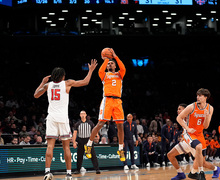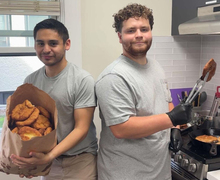ESF : Giving back: ESF recognized as top college for community service
UPDATED: Sept. 20, 2011, 10:28 p.m.
Washington Monthly magazine recognized SUNY-ESF in its 2011 college rankings for being one of the top 10 universities in the country for community service.
The study examined how schools give back to their communities based on social mobility, research and service, according to a Huffington Post article published online Sept. 2.
The State University of New York Environmental Science and Forestry ranked 10th in the nation for accumulating close to 70,000 hours of community service each year during its Saturday of Service and service learning projects, according to the article. Institutions on the West Coast, such as the University of California-Riverside and the University of California-Los Angeles ranked highest in the study.
Liz Mix, the community service and learning coordinator at ESF, said that as a school ESF isn’t often looking for recognition like this, but it’s great for the students, faculty and staff to see that their work is indeed appreciated.
‘We have a very strong culture here of students who are very interested in the community, and we want to make our environment a better place,’ she said.
Mix said students participate in a range of volunteer activities during the college’s annual Saturday of Service, including cleaning debris from Onondaga Creek in the city of Syracuse. This event introduces incoming freshmen to the campus as well as ESF’s mission of service.
This year, freshmen contributed their time at one of ten local parks during the Saturday of Service, Mix said. Freshmen must complete at least one service project during their fall semester, but many end up completing up to four or five, Mix said.
‘This class, in particular, is extremely interested in these projects,’ she said.
Students also participate in service learning projects, which incorporate some sort of community service activity within a course, Mix said. Hours contributed through service learning projects and the Saturday of Service events make up the 70,000 hours of community service ESF generates per year, Mix said.
Dunn said that for such a small school — ESF enrolls 2,200 — students participate in 30 to 40 community activities per year.
One of the most popular organizations on campus is the Green Campus Initiative, a student-run group dedicated to making ESF a more ‘green’ environment, said Paul Otteson, the GCI club adviser.
Otteson said members have been busy working on a multitude of sustainability projects, such as the de-lamping effort. Students survey hallways and ESF classrooms, noting how long lights remain on and how much energy is being used. Then they attempt to reduce that number by placing reminder stickers on the light switches.
The club has also spent a great deal of time producing recycled notebooks and composting food waste, Otteson said.
Overall, the club has about 25 active members, but there are many more on the listserv that come out to certain events, Otteson said.
Otteson said the organization is an important asset to ESF because it acts as a model of sustainability, just like the school. But student members also have a personal connection to the group.
‘Many of them are here seeking degrees where they can go out in the world and have important roles in the environment and sustainability, design, urban planning — all the fields that ESF offers,’ Otteson said. ‘For them, it’s a real proving ground where they can go out and be active on their own kind of personal missions.’
Mix, the community service and learning coordinator at ESF, said the school added her position three years ago when it realized there was a need for a full-time staff member to be in charge of the service programs because it was expanding so much.
She said: ‘It’s important enough to have one staff person dedicated to this.’
Published on September 18, 2011 at 12:00 pm
Contact Liz: egsawyer@syr.edu | @3sawyer





